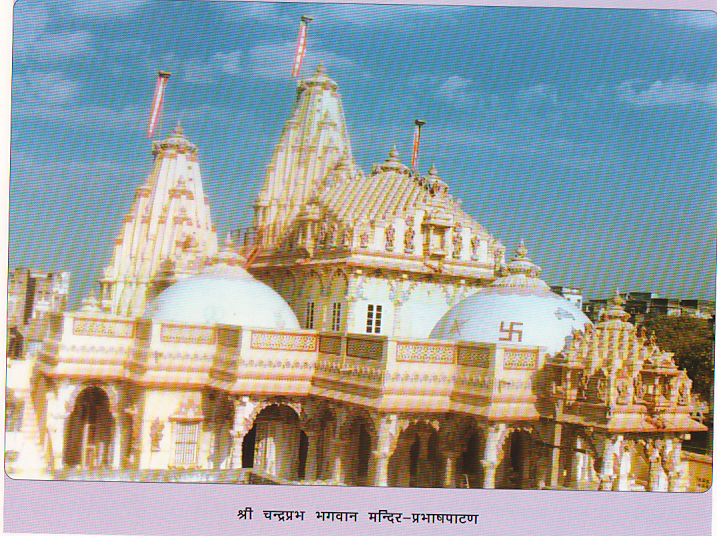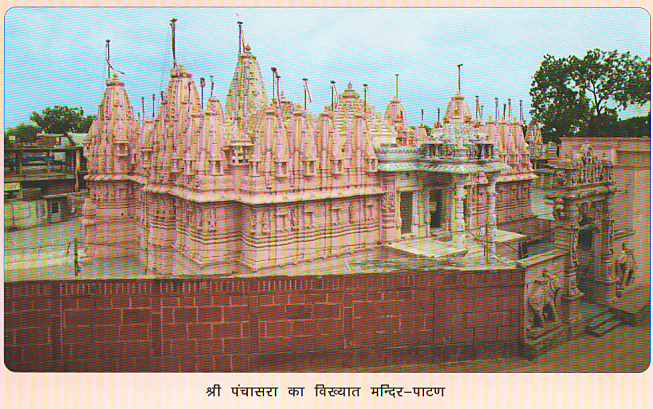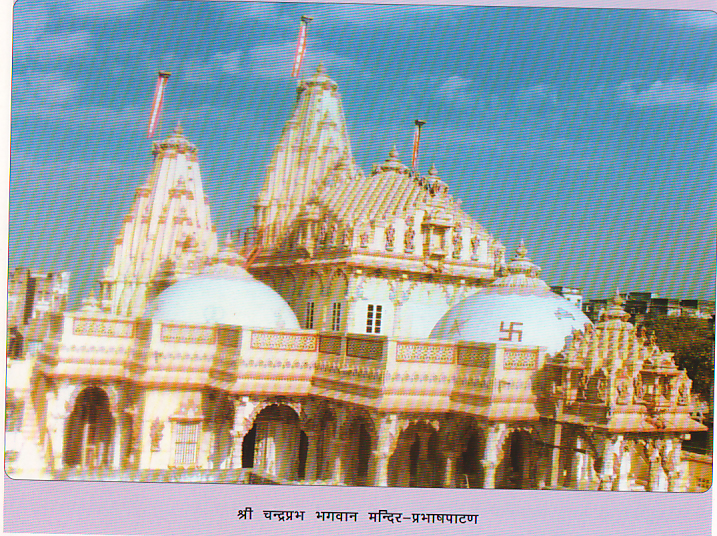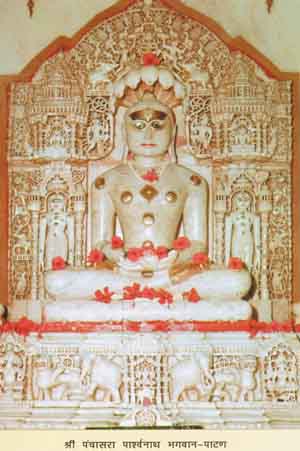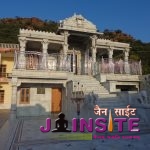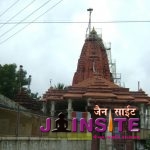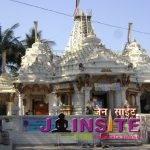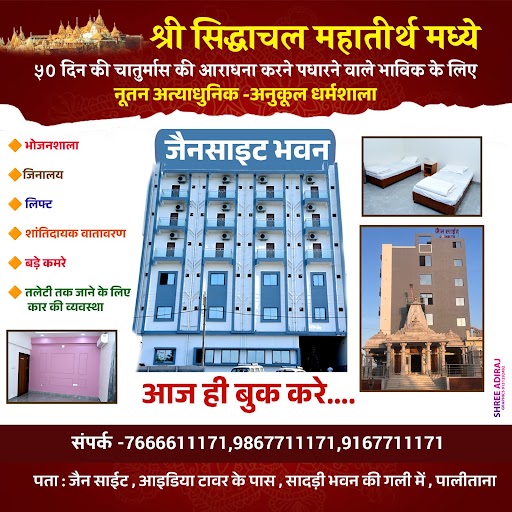SHRI PATAN TIRTH
PRESIDING DEITY AND LOCATION :
Shri Panchasara Parshvanath Bhagwan in white color seated in a lotus posture, of height 1.2 meters in the city of Patan. (Shve).
ANTIQUITY AND SALIENT FEATURES :
The history of this city begins with Vikram year 802 but the idol of this, Sri Panchasara Parshvanath is much more ancient. The city has an history not only ancient but also proud and worthy of deep research. The brave king Vanraj of Chawda dynasty was anxiously searching for a piece of powerful land which, not only can compensate for the loss and fall of Vallabhi and Bhinmal but also be developed into a flourishing glorious capital town for his kingdom. He discussed the subject with and sought advice from Anahil Bharwas Gopalak who was then known to be a king among intuitionists and logistics and directed him to find out such land. Anahil Bharwad saw here the best land which was being further purified by the flowing waters of river Saraswati, A dog and a jackal together on the land according to him was an auspicious omen. He therefore advised the king to found his capital here. In accordance with Jain scriptures, on this land shown by Anahil Bharwad, the foundation stone for the city was laid on the holy day of Monday the 3rd of bright half of the month of Vaishakh in Vikram year 802 by the hands of Nagendra Gachchha Acharya Sri SHilgunsuriji at the instance of Jain Shreshthi Sri Champa among intonations of mantras (incantations) named the city as Anihalpur Patan. Brave king Vanraj Chawda was then decorated with a Raj-Tilak (sign of a king) at the hands of Sri Devim a female householder (Shravika) and was crowned as a king. He was ceremonially seated on a king’s throne. Vanraj thereafter, bringing this divine, unequalled and unsurpassable idol of Sri Parshvanath Bhagwan from the capital of his ancestors named Panchasar in a large procession accompanied with bands and trumpets amidst joyful and enthusiastic festivities, got the same ceremonially installed in the newly built majestic temple at the hands of Sri Shilgunsuriji, as a result of which this shrine became famous as the shrine of “Panchasara Parshvanath”. After Vanraj from 9th to 14th Vikram centuries several kings of Chawda dynasty viz Kshemraj, Bhuwad, Vajrasinh, Ratnaditya, Samantisinh etc., ruled this area. Then followed Jain Kings of Chalukya (Solanki) dynasty viz Sri Kumarpal etc., According to some references, during their period also several Jain temples were built such as Vanraj Vihar, Mulraj Vasahika, Rai Vihar, Tribhuvan Vihar, Kumar Vihar, etc., Besides these, hundreds of other Jain temples were built here. In the course of time during Vikram years 1252 and 1356, the army commander of Allauddin started destroying the city of Patan and several temples were broken and destroyed. The flourishing city was totally plundered and pillaged. According to the discovery of Panyas Sri Kalyan Vijayji, in Vikram year of about 1370, new Patan was inhabitated and several new temples began to be constructed. In accordance with the rites and rituals connected with Khartar Gachchha during Vikram years 1379 and 1381 many Jain temples and idols of Acharya Gurus were consecrated and ceremonially installed at the hands of Sri Jinkushalsuriji. There is a reference available which states that during Vikram years 1417 and 1422 many Jain temples were ceremonially consecrate. In a composition entitled “Patan Chaitya Paripati” by Sri Lalitprabhsuriji in Vikram year 1648, it is stated that the number of large Jain temples in Patan was 101 and that of small temples was 99. These temples housed thousands of idols in which 38 idols were made of Jewels and Precious stones. In another composition entitled “Chaitya Paripati” by Sri Harsh Vijayji in Vikram year 1729, it is mentioned that the number of large temples was 95 and that of small temples over 500. Even today in Patan there are hundreds of Jain temples. It is believed that this temple was repaired and renovated when Patan city itself was resurrected but the idol is the same ancient one which still exists at present.
Patan is only one such city where from the very day of its foundation in Vikram year 802 till to-date hundreds of Jain temples always existed though in between for some years there was a total destruction. Not only for Patan along but for the whole country this period appeared as a dark cloud. In the history of Jainism, probably the event of founding a city according to Jain rites and rituals by Jain Acharya is only this one.
Many records are available about the kings, ministers and shreshthis of Patan having built Jain temples and performed charitable deeds of general welfare not only in Patan but also in many other places in India. There was great prosperity and affluence in Patan during Vikram 9th to 14th centuries. During this period many brave and devout Jain kings and ministers lived here. Jain Shreshthi Sri Nanasha resident of Bhinmal and minister of king Vanraj Chawda and his successors Lahar, Vir, Nedh, Vimal, Dhaval, Anand, Prithvipal etc., who also were ministers lived here. Besides these, Jamb, Champak, Munjal, Santu, Sajjan, Udayan, Bahad, Ashuk, Alik, Solak, Kapadi, Kumarsinh, Vaduyan, Ambad etc., were also Jain Shreshtis, ministers and statesman who lived here and performed deeds of glorification of Jain religion at various places. In a composition entitled “Kumar Pratibodh” by Somprabhsiriji it is mentioned that when Kalikal Sarvagna Sri Hemchandracharya entered the city of Patan, it had the circumference of 13 Kms, 84 quadrangular crossings of roads and 84 markets. On that occasion 1800 millionaire householder Jain families had gathered together and the whole city was shining brightly having illuminated by myriad lights. Sri Hemchandracharya composed many books living in this city which was a great centre of education and culture honored by also other stalwart scholars like Sri Abhaydevsuriji, Sri Malaygiri, Sri Yashchandra, Sri Somprabhcharya, Pragnachakshu (blind( Rajkavi, Shripal etc. Almost all Jain Acharyas of all Gachchha had visited this city for participation in the work of spreading Jain religion. Sri Devsuriji was honored here with the title of “Vadi”, a scholar debater. The marvelous works of stunning craftsmanship and artistry done on Mt. Abu and Mt. Girnar by Patan citizens the commander of the army of Raja Siddharaj Sri Sajjansha are world famous. Sri Samarasha who carried out extensive repairs and renovations on Mt. Shatrunjay in Vikram year 1371 also belonged to this city. Countless affluent Jain householder shreshthis of Patan have in this way utilized their wealth, power and energy in performing religious deeds. The store house (blandar) of Jain scriptures in Patan is widely known. Patan has carved out in history for itself a place of pride and honor defending for truth, showing bravery, maintaining holiness and exhibiting spirit of adventure. Patan is indeed a treasure house of Jain literature, art and culture.
Besides this temple, there are at present in 55 mohollas of Patan 84 large temples and 115 small temples. There are also several Jain institutions and organization including Sri Hemchandracharya Gnan Mandir, Everywhere ancient art of a high ranking order is visible in the temples.
APPROACH – ROUTE :
Railway station as well as bus stand is 2 Kms away from the temple. Mehsana is around 50 Kms,Siddhapur 30 Kms, Charup 12 Kms, Shankeshwar 70 Kms, Chansma 19 Kms, Deesa 50 Kms and Ahemdabad is around 130 Kms away from here. Buses and taxis are available at all these places and they can go upto the temple.
AMENITIES FOR JAIN PILGRIMS :
For lodging and boarding dharamshala and bhojanshala with facilities are available.
MANAGED BY :
Shri Panchasara Parshvanath Jain Derasar Trust
Hemchandracharya Road, Azad CHowk,
P.O. Patan – 384 265,
Dist : Patan , Gujarat.
Tel: 02766 – 22278 / 20559.
